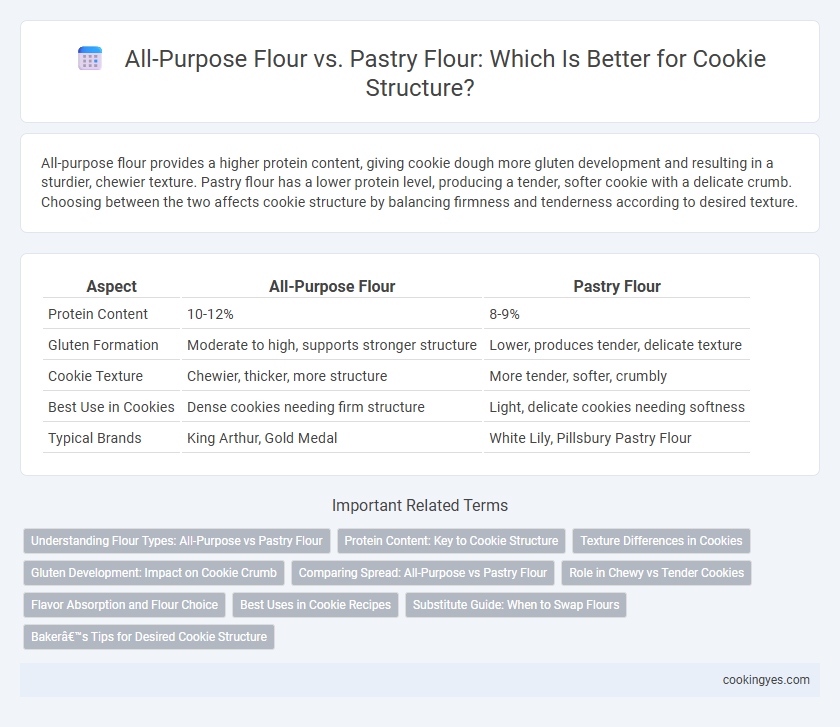All-purpose flour provides a higher protein content, giving cookie dough more gluten development and resulting in a sturdier, chewier texture. Pastry flour has a lower protein level, producing a tender, softer cookie with a delicate crumb. Choosing between the two affects cookie structure by balancing firmness and tenderness according to desired texture.
Table of Comparison
| Aspect | All-Purpose Flour | Pastry Flour |
|---|---|---|
| Protein Content | 10-12% | 8-9% |
| Gluten Formation | Moderate to high, supports stronger structure | Lower, produces tender, delicate texture |
| Cookie Texture | Chewier, thicker, more structure | More tender, softer, crumbly |
| Best Use in Cookies | Dense cookies needing firm structure | Light, delicate cookies needing softness |
| Typical Brands | King Arthur, Gold Medal | White Lily, Pillsbury Pastry Flour |
Understanding Flour Types: All-Purpose vs Pastry Flour
All-purpose flour contains a moderate protein content of 10-12%, providing enough gluten formation for a balanced structure in cookies, resulting in a chewy texture. Pastry flour, with a lower protein content of 8-9%, produces a tender, crumbly cookie by limiting gluten development and enhancing softness. Choosing between all-purpose and pastry flour directly influences cookie texture, from crispiness to delicate crumb.
Protein Content: Key to Cookie Structure
Protein content significantly influences cookie structure, with all-purpose flour typically containing 10-12% protein compared to pastry flour's 7-9%. Higher protein in all-purpose flour creates more gluten, resulting in chewier, denser cookies, while the lower protein in pastry flour produces tender, flaky textures. Selecting the right flour based on protein levels is crucial to achieving the desired cookie consistency and structure.
Texture Differences in Cookies
All-purpose flour creates cookies with a balanced structure, offering moderate gluten development that results in a chewy yet sturdy texture. Pastry flour, lower in protein, produces cookies with a tender, delicate crumb and softer bite due to reduced gluten formation. Understanding these texture differences helps bakers choose the ideal flour to achieve either crispness or softness in their cookie recipes.
Gluten Development: Impact on Cookie Crumb
All-purpose flour contains higher protein content (10-12%) compared to pastry flour (7-9%), which leads to increased gluten development and a chewier cookie crumb. Pastry flour's lower gluten potential creates a tender, crumbly texture ideal for delicate cookies. Choosing flour affects cookie structure by balancing gluten formation and crumb tenderness.
Comparing Spread: All-Purpose vs Pastry Flour
All-purpose flour produces cookies with a balanced spread due to its moderate protein content, offering a chewy texture and defined edges. Pastry flour, with lower protein levels, results in less spread, creating softer, more tender cookies with a delicate crumb. Understanding these differences helps bakers achieve desired cookie shapes and textures by selecting the appropriate flour.
Role in Chewy vs Tender Cookies
All-purpose flour provides higher protein content, typically around 10-12%, which develops more gluten and results in chewier cookies with a sturdier structure. Pastry flour, with lower protein content around 8-9%, creates less gluten, producing tender, softer cookies that easily crumble. Choosing all-purpose flour enhances cookie chewiness and structure, while pastry flour emphasizes tenderness and delicate texture.
Flavor Absorption and Flour Choice
All-purpose flour provides a balanced protein content of 10-12%, offering strong gluten development for sturdy cookie structures, while pastry flour, with its lower protein content around 7-9%, produces more tender, delicate textures. Pastry flour has a finer grind and higher starch content, enhancing flavor absorption and allowing spices and extracts to shine more intensely in cookies. Choosing between all-purpose and pastry flour depends on the desired cookie texture and flavor profile, with all-purpose delivering structure and pastry flour maximizing flavor infusion.
Best Uses in Cookie Recipes
All-purpose flour provides a balanced protein content of 10-12%, creating a sturdy yet tender cookie structure ideal for classic chocolate chip or sugar cookies. Pastry flour, with its lower protein content of around 8-9%, yields a softer, more delicate crumb perfect for crumbly, melt-in-your-mouth cookies like shortbread or snickerdoodles. Using all-purpose flour ensures durability and chewiness, while pastry flour enhances tenderness and a lighter texture in cookie recipes.
Substitute Guide: When to Swap Flours
All-purpose flour offers a higher protein content (10-12%) than pastry flour (7-9%), providing stronger gluten development for cookies needing crispier or chewier textures. Pastry flour's lower protein content creates a tender, crumbly structure ideal for delicate cookie varieties like shortbread or snickerdoodles. Substitute pastry flour for all-purpose when seeking a softer bite, but increase flour quantity slightly to maintain dough consistency.
Baker’s Tips for Desired Cookie Structure
All-purpose flour provides a balanced protein content (10-12%) ideal for sturdy cookie structures with a chewy texture, while pastry flour, having lower protein (8-9%), yields tender, delicate cookies with a softer crumb. Bakers seeking crisp, well-defined edges should opt for all-purpose flour, as its higher gluten formation enhances dough elasticity and spread control. For softer, melt-in-your-mouth cookies, using pastry flour reduces gluten development, creating a finer crumb and preventing excessive toughness.
All-purpose flour vs Pastry flour for structure Infographic

 cookingyes.com
cookingyes.com